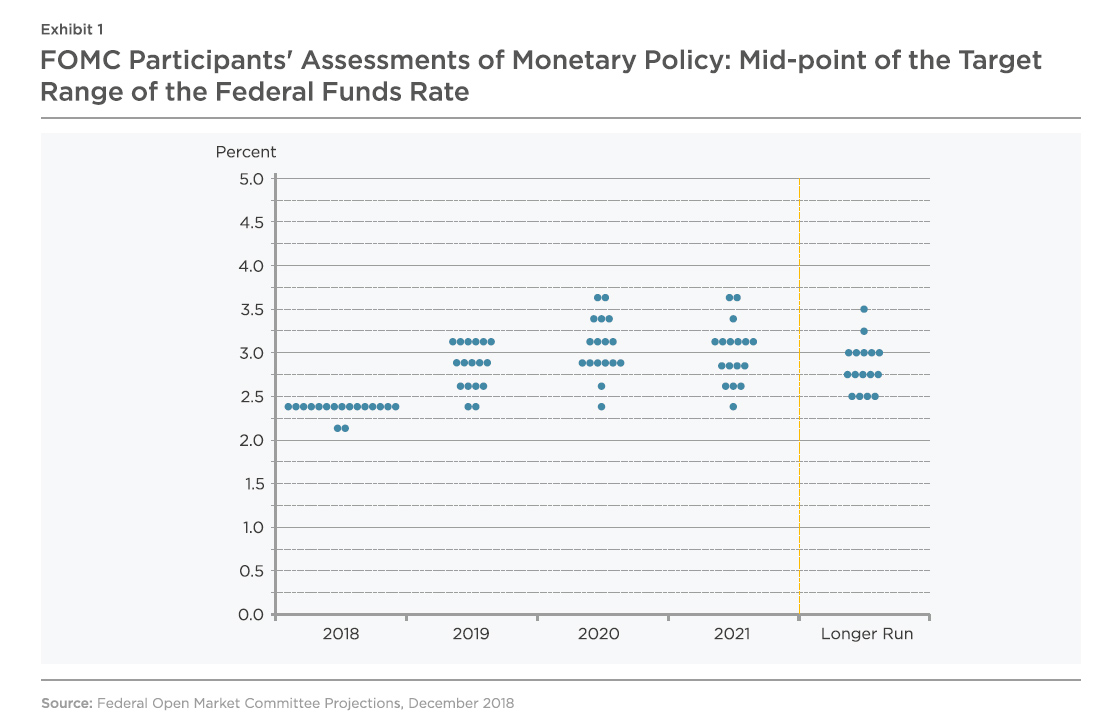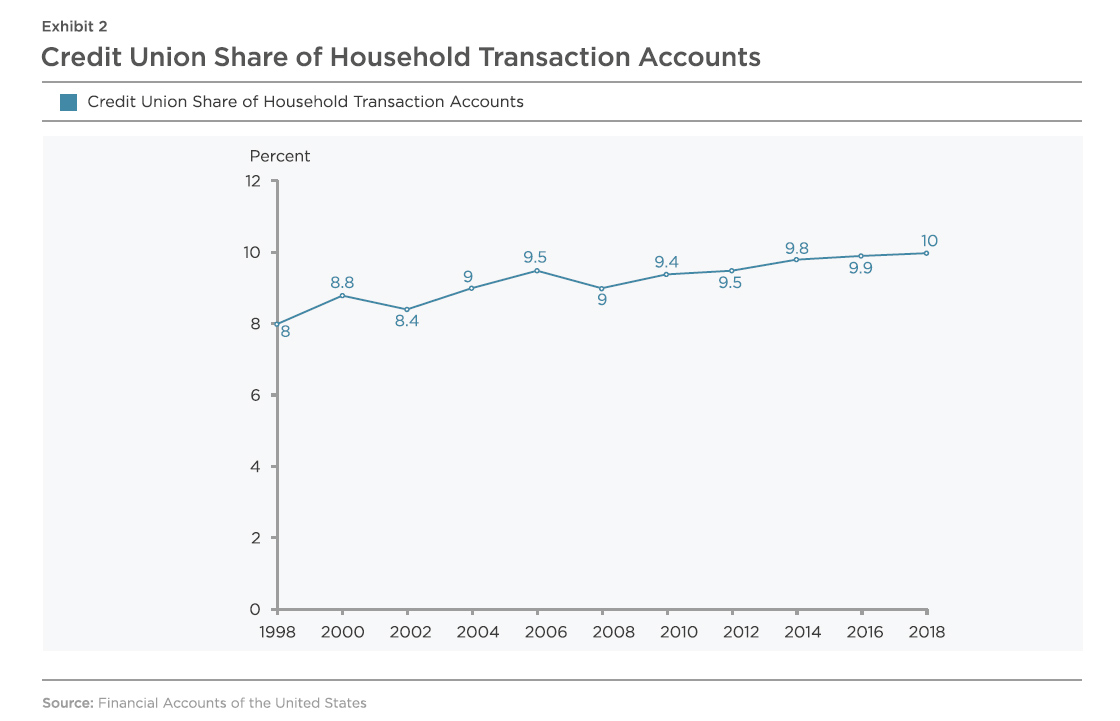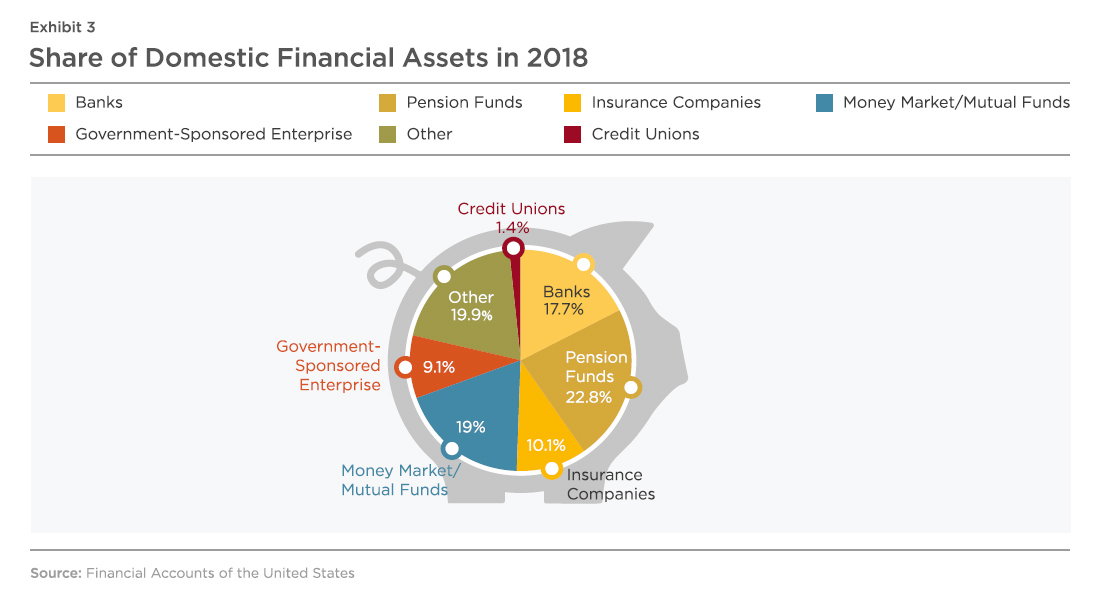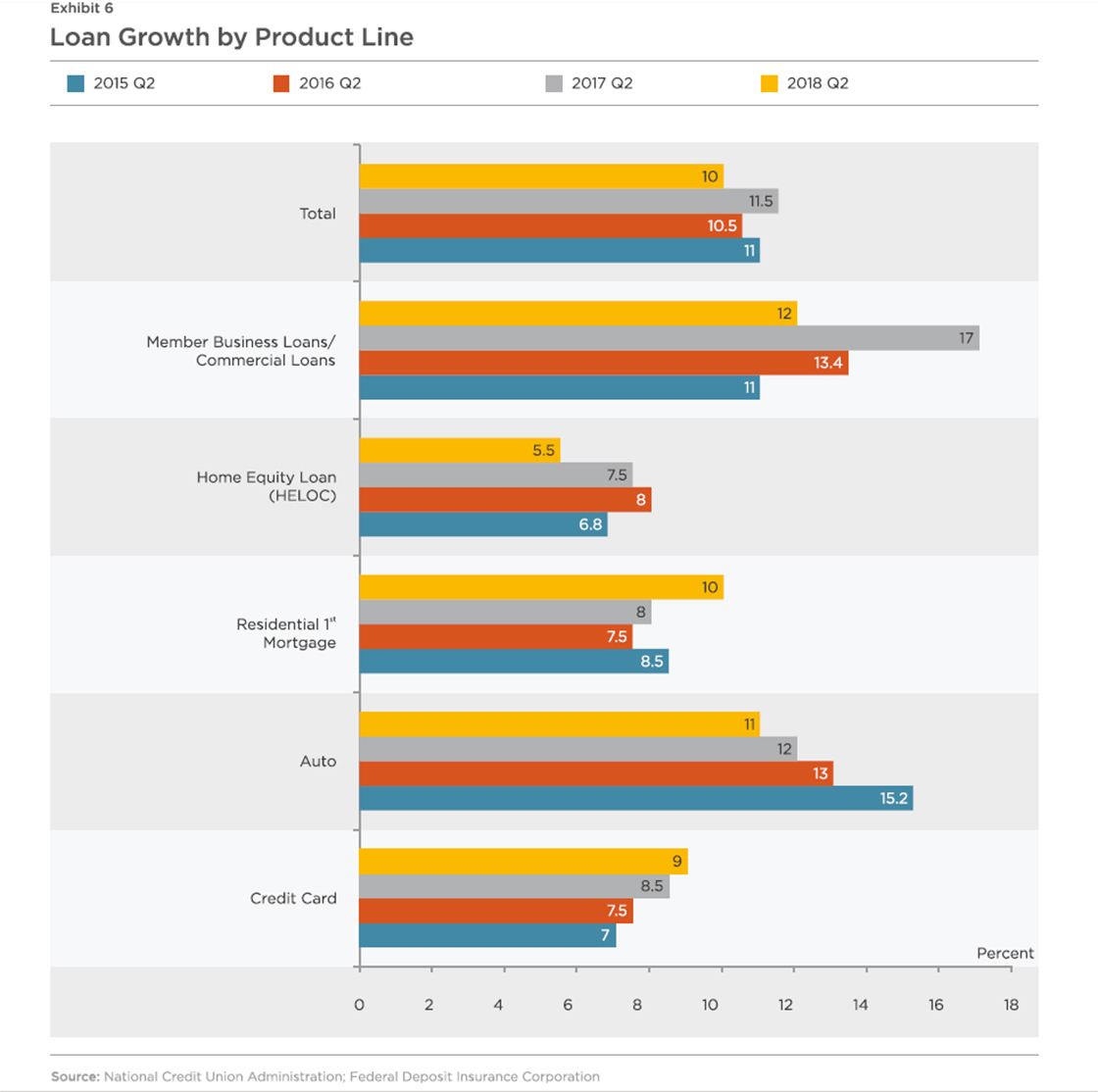Overview
Credit unions, while being a small contributor to the U.S. financial
services industry, hold significant importance for their members.
They have maintained a strong loan growth over the years, with
industry loans exceeding USD 1 Trillion in the second quarter of 2018.
The interest rate environment as dictated by the U.S. Federal
Reserve's (Fed) policies impact the growth and performance of
credit unions. There is a clear trend of increasing interest rates over
the last four revisions in 2018. With indicators pointing at a slower
growth in 2019, the Fed has already marked down its growth and
inflation projections. Recent policy briefings signal further rate rises
in the medium term.
Credit unions are feeling the impact of the rising rates. For example,
auto loans, constituting approximately 35 percent of their portfolio,
have witnessed a decline in the past year. Further, credit unions also
experienced a flat quarter-on-quarter yield on loans in 2017-2018.
Credit unions will need to re-assess their lending and investment
strategies in the current environment. They have to find ways to
continue lending while maintaining adequate liquidity. Building a
contingency plan for any short-term change is also recommended.
This WNS DecisionPointTM report analyzes the growth trajectory of
credit unions, in loans, assets and membership, across categories in
context of the interest rate policies. It also discusses the possible
options and approaches credit unions can take to deal with the
situation in the near future.
U.S. CREDIT UNIONS: WALKING THE TIGHTROPE
BALANCING GROWTH IN A RISING INTEREST RATE ENVIRONMENT
- As interest rates continue to
rise due to the U.S. Federal
Reserve's policy, consumer
lending is likely to experience
further slowdown in 2019
- Credit unions now have to
re-assess their lending and
investment strategies, while
maintaining liquidity
- A WNS DecisionPoint analysis
shows that if policymakers
allow credit unions more
opportunities to partner with
small businesses, it will have
far-reaching implications for
the industry
U.S. CREDIT UNIONS: WALKING THE
TIGHTROPE
BALANCING GROWTH IN A RISING INTEREST RATE ENVIRONMENT
In its latest policy review, the
United States (U.S.) Federal
Reserve (Fed) continued on its
trajectory of rate hikes by raising
the target range of the federal
funds rate to 2.25-2.5 percent. This
is the fourth rate hike in a series of
three consistent rate hikes in 2018.
Economic data monitored by the
Fed indicates that the labor market
has continued to strengthen amid
strong job gains and a low
unemployment rate. The Fed has
indicated two rate rises ahead for
2019 in the wake of softening economic data and anticipated
global growth slowdown.
A look at financing conditions in
the consumer credit markets
presents a mixed picture. While
nurturing of growth in household
spending, interest rates on
consumer loans continued to rise.
In the residential mortgage market,
tight financing conditions persisted
for borrowers with low credit
scores. There was a slowdown in
the growth of home-purchase
mortgage originations as mortgage rates reached their highest level
since 2011, and refinancing activity remained muted.1
Consumer lending is likely to
experience further slowdown in
2019. The path of U.S. rate rises
over the course of next year will
determine the lending strategies of
credit unions and their subsequent
growth. In the coming sections, we
will assess the forecasts for U.S.
interest rate rises and how these
will impact credit unions and their
lending portfolios.
FORECAST OF U.S. INTEREST RATE TRAJECTORY
In its press conference held on
December 19, 2018, the U.S. Fed
singled out two important points
that will differentiate the trajectory
of U.S. interest rates in 2019 from
that of 2018. Firstly, 2019 will
witness moderate growth
compared to the rising pace of
growth in 2018. The additional tightening of financial conditions
seen over the last couple of months
combined with signs of weaker
growth seen outside of the U.S.,
have led the Fed to mark down its growth and inflation projections.2
Secondly, the U.S. economy
continued to strengthen in 2018.
Given the four rate hikes, the Fed signaled that it will be providing a
smaller boost to the economy in
2019 and put the target rate for the
Fed between 2.25 to 2.5 percent, at
the lower end of the range of
estimates provided by the Federal Open Market Committee (FOMC).3


The chart describes the
policymakers' assessments of the
future path of monetary policy.
Each shaded circle (rounded to the
nearest 1/8 percentage point) indicates an individual participant's
perception of the mid-point of the
target range of the federal funds
rate toward the end of the year.
With at least two more rate rises anticipated in 2019, U.S. interest
rates are set to follow a rising
course in the medium-term, with
far reaching implications for the
credit union industry.
CREDIT UNIONS: INDUSTRY TRENDS
Credit unions are member-owned,
non-commercial cooperative
financial institutions. They are run
autonomously, led by directors
who offer their services for free
and function to serve their field of
membership. In terms of size,
they occupy a tiny proportion of
the U.S. financial services industry,
and yet they are of paramount
importance to their members. The vast majority of credit unions
are small financial institutions
trying to gain a footing in the
highly competitive financial
services industry. The median
credit union manages a meagre
USD 33 Million in assets and has 8 full-time employees.4 By
comparison, the median bank
has more than USD 210 Million in
assets and 45 full-time employees. In addition, the credit union
industry is less top-heavy than
the banking industry. The top
100 banks represent 81 percent
of total bank assets, whereas the
top 100 credit unions only account
for 44 percent of industry assets.
Each of the three largest banks
accounts for more assets than all
5480 credit unions combined.


Year-over-year growth in credit union membership was 4.3 percent in June 2018, its highest level in three decades.5
HOW HAVE RISING U.S. INTEREST RATES AFFECTED CREDIT UNION LENDING?
In recent policy briefs, the Fed has indicated more rate rises in the medium- term, thereby pushing credit unions
to reassess their lending and investment strategies.
An assessment of credit extension
by type of institution reveals a
pattern of credit unions maintaining
a flow of credit to the small businesses sector. As policymakers
grapple with the prospects of a
slowing economy in the near-term
and decline in business dynamism, they would do well to provide
credit unions with more
opportunities to partner with
small businesses.


Credit unions have maintained
strong loan growth over the years.
In the second quarter of 2018, total
industry loans outstanding
exceeded USD 1 Trillion. More than 70 percent of that comprises
first-lien residential mortgages and
auto loans (35 percent each). The
remainder of the loan portfolio
consists of junior-lien residential loans (8 percent), commercial loans
(7 percent), credit card loans
(6 percent) and unsecured
personal loans or lines of credit (4 percent).6
Auto lending has been a key
component of the industry
lending, propelling total loan
growth for years. However, auto
sales have declined sharply from a
year ago, primarily due to rising
interest rates which have led to a
fall in auto loans. As rates continue
to rise, auto companies enjoy
greater flexibility with regard to
offering low rates on vehicles,
thereby potentially gaining an
advantage over credit unions and
taking a small amount of business
away from them. Also, consumers
have been used to low interest
rates for a very long time. Hence,
even a slight increase in interest rates might steer consumers away
from loans.
So what strategies can credit
unions deploy to stay afloat in
the rising interest rate tide? One
of the best ways to combat the
challenge is to continue to loan
as much as they can, while
maintaining adequate liquidity
to service the members' financial needs.7 A proper contingency plan
must be in place should credit
needs change in the short-term.
Yields on loans have consistently
declined over the last several years,
but stayed flat quarter-on-quarter
in 2017 and 2018 - a clear indication that credit unions are
starting to feel the impact from
the re-pricing of newly originated
loans. Credit unions are facing
increasing pressure both from
consumers to increase deposit
rates and from internal business,
as loan growth has outpaced share
growth and created a need for
additional deposits to fund future
loan growth. One way to meet this
challenge and fight rising interest
rates would be to offer more
adjustable-rate products, enabling
an increase in expected income as and when rates rise.8

OUTLOOK FOR CREDIT UNIONS
Based on actual historical data
from the Credit Union National Association, WNS DecisionPointTM has created loan growth, asset
growth and membership growth
estimates and forecasts of credit
unions for the third and fourth quarter of 2018. Credit unions have
enjoyed a period of high growth
across the three categories through
2017 and the first two quarters of
2018. However, with spikes in
interest rates having taken a toll
on loans, assets and membership, WNS DecisionPointTM estimates a
downward trend for the remaining
two quarters of 2018 and an overall
decline from previous years across
the three categories.
Conclusion
Rising interest rates in the U.S. in
the last one year have had an
adverse impact on the credit union
industry as consumers steered
away from loans. Key components
of credit union loan growth, such
as auto loans, have witnessed a
slight decline as interest rates rose
and consumers started to postpone their auto purchases. In order to
maintain healthy levels of asset and
loan growth, credit unions will have
to adopt a host of strategies,
ranging from creating more diverse
rate-adjustable loan products in
their portfolio offerings to
maintaining adequate levels of
liquidity to satisfy consumers' credit needs. With the Fed
expected to go in for further rate
rises in 2019, it would be interesting
to see how credit unions balance
their asset and loan growth with
increasing pressures on liquidity
levels in the industry.

References:
1. Minutes of the Federal Open Market Committee, November 7-8, 2018
2. Transcript of Chairman Powell's Press Conference Opening Remarks, December 19, 2018
3. Ibid
4. 2018 NAFCU Report on Credit Unions, National Association of Federal Credit Unions
5. Ibid
6. 2018 NAFCU Report on Credit Unions, National Association of Federal Credit Unions
7. 'As interest rates climb, how should credit unions respond and strategize?', Credit Union Journal, March 2018
8. Ibid